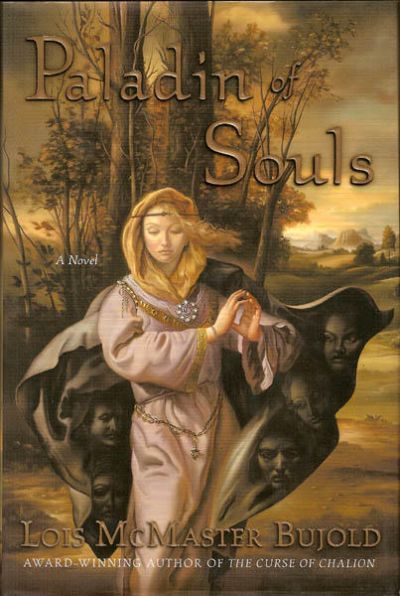Whatever Happened to Lady Ista?
Paladin of Souls (Chalion, volume 2)
By Lois McMaster Bujold

16 Apr, 2016
0 comments
One of downsides of having other people pick what I read is that not only do I miss perfectly good books that were assigned to other reviewers, but I am often so busy reading what I must that I don’t have much free time for unassigned reading. I miss good books that way. One of those books was 2003’s Paladin of Souls. This is another novel set in the world of the Five Gods, the world introduced in The Curse of Chalion1. I like Bujold’s work; this was a Hugo-winning work; ergo, this was something I wanted to read. I just never found the time.
Until now.…
Finally freed of the Golden General’s curse and the god-touched madness that afflicted her, Ista tires of the boring, custom-bound life of an aristocratic lady. She seizes on the one avenue of escape that is open to her: pilgrimage.
Ista sets out with fellow pilgrims and a small squad of guards. Her company is large enough, and armed enough, to scare off the usual sort of rustic bandits. Her guards, heavily outnumbered, are much less effective against a roving band of Roknari soldiers. Ista is captured, much to the glee of the Roknari. Clearly aristocratic, Ista will command a large ransom (just how large, the Roknari have no idea, since they do not know the woman they captured is the mother of the queen). The gods, and luck, and men with pointy swords, intervene, and Ista is rescued.
Ista and her surviving friends reach a fortress that turns out to offer only temporary safety. It is menaced by a hidden demon within, as well an approaching Roknari army without. From frying pan to fire : from hostage to besieged.
The worst of it is that the sorceress leading the Roknari army has at her command something new: a legion of demons, acting in concert.
~oOo~
Bujold’s world is modeled on 15th century Spain and the Castilian wars of conquest. The Roknari take the place of Muslims, in a way I found problematic. It seems as if the only good Roknaris are dead Roknaris (excepting a few renegades). The Roknari commit atrocities (mostly off-screen but described in some detail). The followers of the Five Gods take the place of the Christians; they are not all saints (except the ones who actually are), but they aren’t as unpleasant as the Roknari. They’re whitewashed Christian-analogs: they are in no way as bloodthirsty and intolerant as the real Isabella I of Castile and Ferdinand II of Aragon. Now, other readers may be perfectly happy with a world divided into white hats and black hats, but I like a little more subtlety and a little less intolerance.
Oh, well. I guess Bujold’s treatment of the Roknari is no worse than C. S. Lewis’ treatment of the Calormen.
I’m also bothered by Bujold’s tolerance for aristocratic rule (as is evident in her other popular series). IMHO, she has stacked the deck by avoiding harrowing depictions of filthy slums and oppressed peasants. The lower classes may not have as much as the aristos, but they seem to lead secure, contented, lower-middle-class lives. It’s the Roknari who have the slums and the oppressed peasants. Because story, I suppose. Bujold needs sympathetic protagonists. If her Chalionites were as brutal as the real life Spanish Christians2, we would be in Game of Thrones territory. Which may be popular now, but it is clearly not the kind of place where Bujold feels comfortable.
Ista has the misfortune to be potentially useful to the gods, and in particular to the Bastard. Human saints are the god’s instruments in the mortal realm; they mediate between spiritual and physical realms. It’s damn hard on them, but the gods would probably argue that what they do is for the greater good. Eggs, omelette, all that. Indeed, Ista may grumble, but she understands that her comfort cannot matter as much as stopping a plague of demons.
I found Ista an interesting and somewhat unconventional character. She’s no ravishingly beautiful, young, single heroine. She’s old enough to be a widow with a grown child. Her daughter plays no great role in this story, but Ista is emphatically a mother. All too many novelists have seen marriage as the proper end of a novel; in this book, it’s backstory.
My editor loves this book and opines that it’s life-affirming to read about an older woman, a mother, who has further adventures and romance. Perhaps because my editor is an older woman and a mother. As for me … while I liked the fact that Ista is an older woman with agency, I found the simplified worldbuilding and aristocratic bias distracting. Your mileage will almost certainly vary. This did win a Hugo and a Nebula, after all.
Paladin of Souls can be purchased here.
1: I am vague about series order because I am still am not quite sure how to sort the books. ISFDB has this chronological (as opposed to publication) order:
World of the Five Gods
1. The Hallowed Hunt (2005)
1.5. Penric’s Demon (2015)
2. The Curse of Chalion (2001)
3. Paladin of Souls (2003)
I’m not sure that I would agree, but I would have to reread the other books, or at least the reviews I wrote, to be sure. And of course by saying that, I ensured I would be compelled to check my old reviews. The ordering system I use has The Curse of Chalion as the first one and Penric’s Demon as the fourth. Because I was going by publication order, not internal order. Thank goodness I am not the sort of obsessive who would let the question of which ordering system to use chew holes in stomach lining.
2: Mann’s 1491 made a fair case that you were safer from religious violence under the Aztec than the Spanish.
